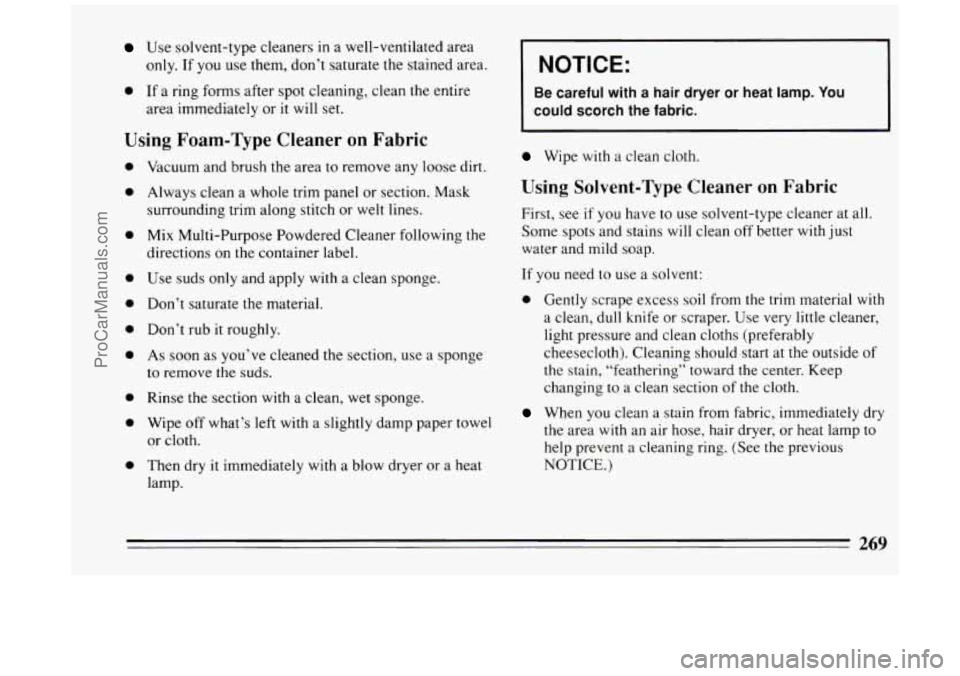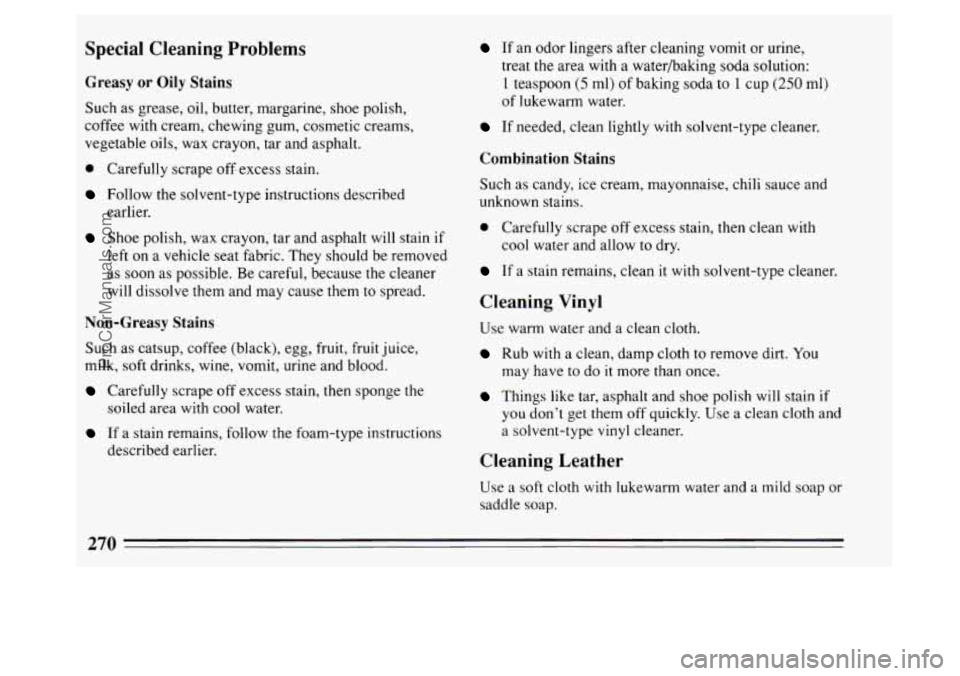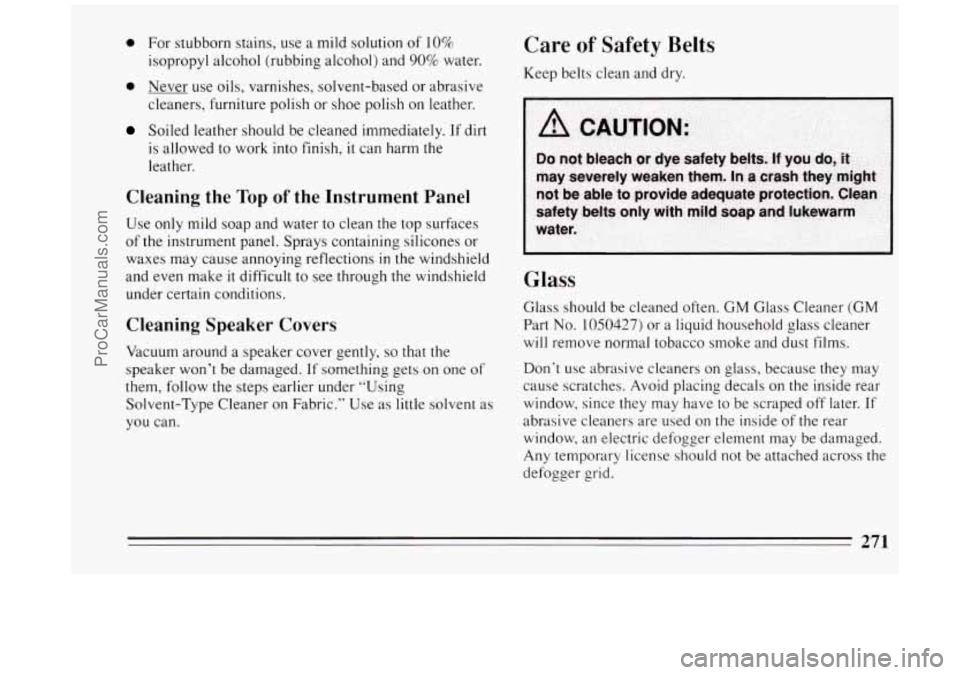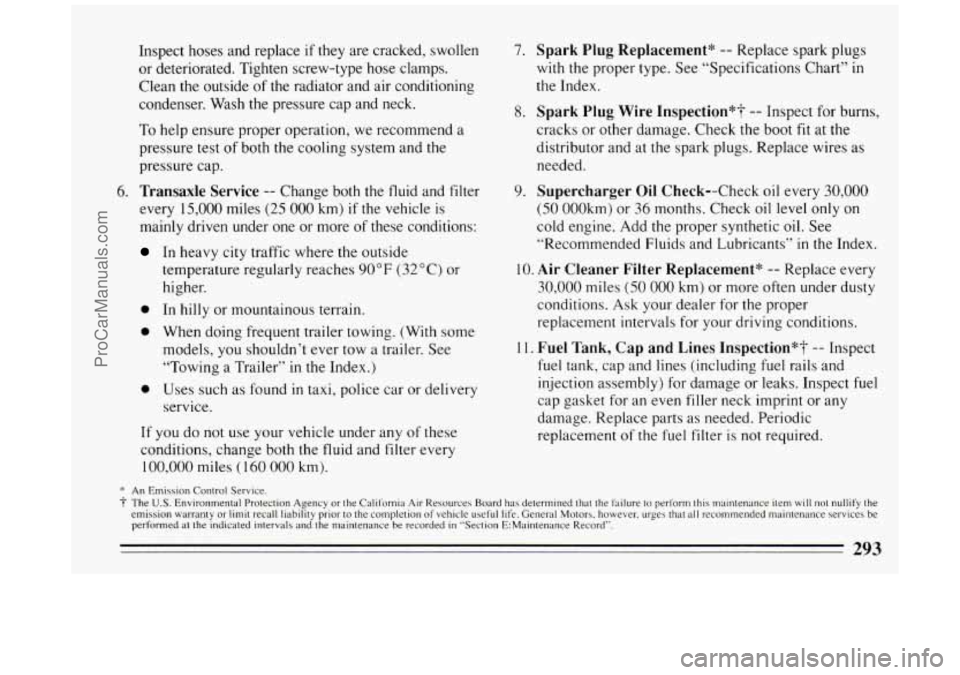1994 BUICK PARK AVENUE oil type
[x] Cancel search: oil typePage 271 of 324

Use solvent-type cleaners in a well-ventilated area
only. If
you use them, don’t saturate the stained area.
0 If a ring forms after spot cleaning, clean the entire
area immediately or
it will set.
Using Foam-Type Cleaner on Fabric
0 Vacuum and brush the area to remove any loose dirt.
0 Always clean a whole trim panel or section. Mask
surrounding trim along stitch or welt lines.
0 Mix Multi-Purpose Powdered Cleaner following the
directions on the container label.
0 Use suds only and apply with a clean sponge.
0 Don’t saturate the material.
0 Don’t rub it roughly.
0 As soon as you’ve cleaned the section, use a sponge
to remove the suds.
0 Rinse the section with a clean, wet sponge.
0 Wipe off what’s left with a slightly damp paper towel
or cloth.
0 Then dry it immediately with a blow dryer or a heat
lamp.
I NOTICE:
I
Be careful with a hair dryer or heat lamp. You
could scorch the fabric.
Wipe with a clean cloth.
Using Solvent-Type Cleaner on Fabric
First, see if you have to use solvent-type cleaner at all.
Some spots and stains will clean off better
with just
water and mild soap.
If you need to use a solvent:
0 Gently scrape excess soil from the trim material with
a clean, dull knife or scraper. Use very little cleaner,
light pressure and clean cloths (preferably
cheesecloth). Cleaning should start at the outside of
the stain, “feathering” toward
the center. Keep
changing to a clean section of the cloth.
When you clean a stain from fabric, immediately dry
the area with an air hose, hair dryer, or heat lamp to
help prevent a cleaning ring. (See the previous
NOTICE.)
269
ProCarManuals.com
Page 272 of 324

Special Cleaning Problems
Greasy or Oily Stains
Such as grease, oil, butter, margarine, shoe polish,
coffee with cream, chewing gum, cosmetic creams,
vegetable oils, wax crayon, tar and asphalt.
0 Carefully scrape off excess stain.
Follow the solvent-type instructions described
earlier.
Shoe polish, wax crayon, tar and asphalt will stain if
left on
a vehicle seat fabric. They should be removed
as soon as possible. Be careful, because the cleaner
will dissolve them and may cause them to spread.
Non-Greasy Stains
Such as catsup, coffee (black), egg, fruit, fruit juice,
milk, soft drinks, wine, vomit, urine and blood.
Carefully scrape off excess stain, then sponge the
soiled area with cool water.
If a stain remains, follow the foam-type instructions
described earlier.
If an odor lingers after cleaning vomit or urine,
treat
the area with a waterbaking soda solution:
1 teaspoon (5 ml) of baking soda to 1 cup (250 ml)
of lukewarm water.
If needed, clean lightly with solvent-type cleaner.
Combination Stains
Such as candy, ice cream, mayonnaise, chili sauce and
unknown stains.
0 Carefully scrape off excess stain, then clean with
cool water and allow to dry.
If a stain remains, clean it with solvent-type cleaner.
Cleaning Vinyl
Use warm water and a clean cloth.
Rub with a clean, damp cloth to remove dirt. You
Things like tar, asphalt and shoe polish will stain if
may
have to do
it more than once.
you don’t get them off quickly. Use a clean cloth and
a solvent-type vinyl cleaner.
Cleaning Leather
Use a soft cloth with lukewarm water and a mild soap or
saddle soap.
270
ProCarManuals.com
Page 273 of 324

0 For stubborn stains, use a mild solution of 10%
isopropyl alcohol (rubbing alcohol) and
90% water.
0 Never use oils, varnishes, solvent-based or abrasive
cleaners, furniture polish or shoe polish on leather.
Soiled leather should be cleaned immediately. If dirt
is allowed to work into finish,
it can harm the
leather.
Cleaning the Top of the Instrument Panel
Use only mild soap and water to clean the top surfaces
of the instrument panel. Sprays containing silicones or
waxes may cause annoying reflections
in the windshield
and even make
it difficult to see through the windshield
under certain conditions.
Cleaning Speaker Covers
Vacuum around a speaker cover gently, so that the
speaker won’t be damaged. If something gets on one of
them, follow the steps earlier under “Using
Solvent-Type Cleaner on Fabric.” Use as little solvent as
you can.
Care of Safety Belts
Keep belts clean and dry.
Glass
Glass should be cleaned often. GM Glass Cleaner (GM
Part
No. 1050427) or a liquid household glass cleaner
will remove normal tobacco smoke and dust films.
Don’t use abrasive cleaners on glass, because they may
cause scratches. Avoid placing decals on the inside rear
window, since they may have to be scraped off later. If
abrasive cleaners are used on the inside
of the rear
window, an electric defogger element may be damaged.
Any temporary license should not be attached across the
defogger grid.
271
ProCarManuals.com
Page 295 of 324

Inspect hoses and replace if they are cracked, swollen
or deteriorated. Tighten screw-type hose clamps.
Clean the outside of the radiator and air conditioning
condenser. Wash the pressure cap and neck.
To help ensure proper operation, we recommend a
pressure test of both the cooling system and the
pressure cap.
6.
Transaxle Service -- Change both the fluid and filter
every
15,000 miles (25 000 km) if the vehicle is
mainly driven under one or more
of these conditions:
In heavy city traffic where the outside
temperature regularly reaches
90°F (32°C) or
higher.
0 In hilly or mountainous terrain.
0 When doing frequent trailer towing. (With some
models, you shouldn’t ever tow a trailer. See
“Towing a Trailer”
in the Index.)
0 Uses such as found in taxi, police car or delivery
service.
If you do not use your vehicle under any of these
conditions, change both the fluid and filter every
100,000 miles ( 160 000 km).
7. Spark Plug Replacement* -- Replace spark plugs
with the proper type. See “Specifications Chart”
in
the Index.
8. Spark Plug Wire Inspection*-f -- Inspect for burns,
cracks or other damage. Check the boot
fit at the
distributor and at the spark plugs. Replace wires as
needed.
9. Supercharger Oil Check--Check oil every 30,000
(50 000km) or 36 months. Check oil level only on
cold engine. Add the proper synthetic oil. See
“Recommended Fluids and Lubricants” in the Index.
10. Air Cleaner Filter Replacement* -- Replace every
30,000 miles (50 000 km) or more often under dusty
conditions. Ask your dealer for the proper
replacement intervals for your driving conditions.
1 1. Fuel Tank, Cap and Lines Inspection*? -- Inspect
fuel tank, cap and lines (including fuel rails and
injection assembly) for damage or leaks. Inspect fuel
cap gasket for an even filler neck imprint or any
damage. Replace parts as needed. Periodic
replacement
of the fuel filter is not required.
* An Emission Control Service.
-f The US. Environmental Protection Agency or the California Air Resources Board has determined that the failure to perform this maintenance item will not nullify the
emission warranty or limit recall liability prior to the completion of vehicle useful life. General Motors. however. urges that all recommended maintenance services be
performed at the indicated intervals and the maintenance be recorded in “Section E:Maintenance Record”.
293
ProCarManuals.com